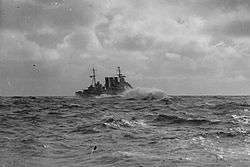HMS Berwick (65)
HMS Berwick, pennant number 65, was a County-class heavy cruiser of the British Royal Navy, part of the Kent subclass. She was built by Fairfield Shipbuilding and Engineering Company (Govan, Scotland), with the keel being laid down on 15 September 1924. She was launched on 30 March 1926 and commissioned 12 July 1927.
.jpg) | |
| History | |
|---|---|
| Name: | HMS Berwick |
| Builder: | Fairfield Shipbuilding and Engineering Company, Govan, Scotland |
| Laid down: | 15 September 1924 |
| Launched: | 30 March 1926 |
| Commissioned: | 12 July 1927 |
| Decommissioned: | 1946 |
| Identification: | Pennant number 65 |
| Fate: | Allocated to British Iron & Steel Corporation for scrapping on 15 June 1948 and arrived at Hughes Bolckow, Blyth, on 12 July for breaking up. |
| General characteristics | |
| Class and type: | County-class heavy cruiser |
| Displacement: |
|
| Length: | 630 ft (190 m) |
| Beam: | 68 ft 3 in (20.80 m) |
| Draught: | 16 ft 3 in (4.95 m) |
| Propulsion: |
|
| Speed: | 31.5 knots (58.3 km/h) |
| Range: | 3,100 nautical miles at 31.5 knots (5,740 km at 58 km/h), 13,300 nautical miles at 12 knots (24,600 km at 22 km/h); 3,400 tons (3,450 t) fuel oil |
| Complement: | 700 |
| Armament: |
|
| Armour: | |
| Aircraft carried: | Three aircraft with one catapult, removed in 1942 |
History

When completed Berwick was sent to the China Station, where she remained until a temporary detachment to the Mediterranean in 1936. Along with the rest of her Kent class sub-group of County-class ships, Berwick underwent reconstruction between 1937 and 1938, where her single 4-inch guns were replaced with double mounts, numerous light machine guns were added, and probably most important; a cemented 4-inch (100 mm) thick and 6 feet (1.8 m) deep armoured belt was added to both sides of her hull beginning at the armoured deck down past her water line. After this work, she completed her sea trials and then proceeded west where she served on the America and West Indies Station with the 8th Cruiser Squadron, based at the HM Dockyard Bermuda, until 1939. When the Second World War started, she served on ocean convoy escort duties, then formed part of Force "F" (with HMS York) when hunting groups were formed to find German raiders. She did not make contact with any raider, but intercepted the mercantile blockade runners Wolfsburg and Uruguay in the Denmark Straits during March 1940.
On 9 April 1940 she participated in the Norwegian Campaign and on 10 May 1940 in the Invasion of Iceland. She was then allocated to Force "H" at Gibraltar arriving on 7 November. On 27 November, while taking part of Operation Collar, Berwick was hit by a single 203 mm (8 in) shell from an Italian heavy cruiser, either Pola or Fiume,[1] which knocked out her "Y" turret and killed seven men. A second round that struck her some minutes later destroyed the after electric switchboard, leaving the cruiser's aft section without power.[2][3] Some sources credit the second hit to a Trento-class Italian cruiser, either Trieste or Trento, the only Italian heavy cruisers within range at the time of the impact.[4]
On 25 December 1940, Berwick engaged the German heavy cruiser Admiral Hipper off the Canaries when she formed part of the escort to convoy WS-5A, a troop convoy to the Middle East. Despite being thoroughly ready for combat Berwick got the worst of the encounter. She scored no hits on Admiral Hipper, and sustained a fair amount of damage, being hit by several 8-inch (which for the most part passed right through the ship) and 4.1-inch shells. The action did however, drive off Admiral Hipper, and saved the convoy from any losses. Four of her complement were killed and she had to return to Britain for repairs, which lasted until June 1941.
When repaired Berwick joined the Home Fleet and for the remainder of her wartime career she was escorting convoys to North Russia and operating in the northern North Sea, where she served under the captaincy of Norman Vere Grace from January to August 1944.[5] In late October 1944 the ship carried Free Norwegian Forces from Britain to Murmansk, so that they could participate in the Liberation of Finnmark.[6] She escorted two carrier raids against the German battleship Tirpitz in 1944 and again in 1945. Berwick's last role was to escort carriers that were raiding the Norwegian coast in 1945.
After the war she was allocated to BISCO for scrapping on 15 June 1948 and arrived at Hughes Bolckow, Blyth, on 12 July for breaking up.
Citations
- Stern, Robert C. (2015). Big Gun Battles: Warship Duels of the Second World War. Seaforth Publishing. p. 60. ISBN 1473849691.
- Casualty Lists of the Royal Navy and Dominion Navies, World War 2, November 1940
- O'Hara, Vincent P.: Struggle for the Middle Sea, Naval Institute Press, Annapolis, Maryland, 2009, pp. 70-71. ISBN 978-1-59114-648-3.
- O'Hara, Vincent P.: Struggle for the Middle Sea, Naval Institute Press, Annapolis, Maryland, 2009. ISBN 978-1-59114-648-3.
- "Norman Vere Grace, RN". www.uboat.net. Retrieved 26 September 2019.
- Simon Orchard, "THE EVACUATION OF FINNMARK & THE RE-ENTRY OF NORWEGIAN FORCES INTO NORWAY, OCT 1944-MAY 1945."
References
- Chesneau, Roger, ed. (1980). Conway's All the World's Fighting Ships 1922–1946. Greenwich: Conway Maritime Press. ISBN 0-85177-146-7.
- Raven, Alan; Roberts, John (1980). British Cruisers of World War Two. Annapolis, MD: Naval Institute Press. ISBN 0-87021-922-7.
- Rohwer, Jürgen (2005). Chronology of the War at Sea 1939–1945: The Naval History of World War Two (Third Revised ed.). Annapolis, Maryland: Naval Institute Press. ISBN 1-59114-119-2.
- Whitley, M. J. (1995). Cruisers of World War Two: An International Encyclopedia. London: Cassell. ISBN 1-86019-874-0.
External links
| Wikimedia Commons has media related to HMS Berwick (65). |